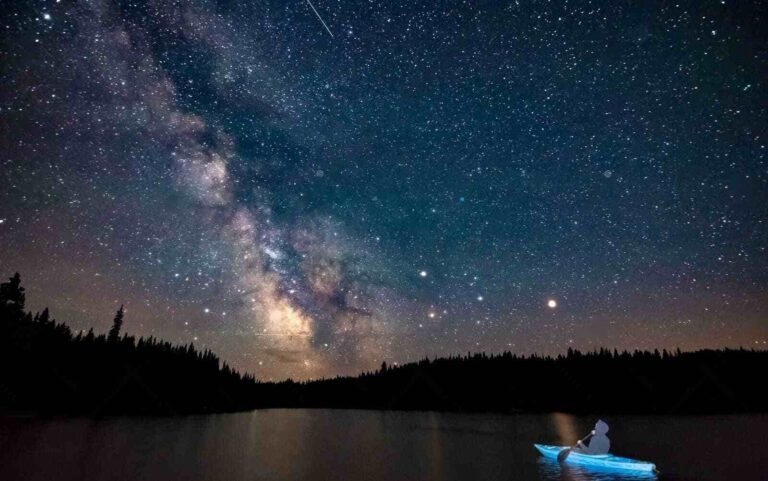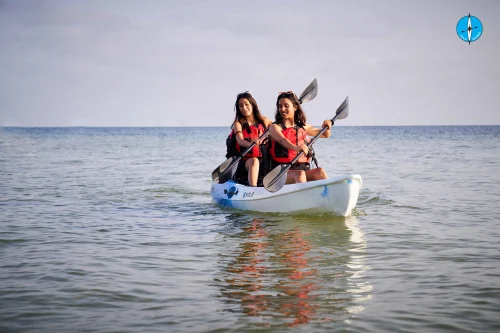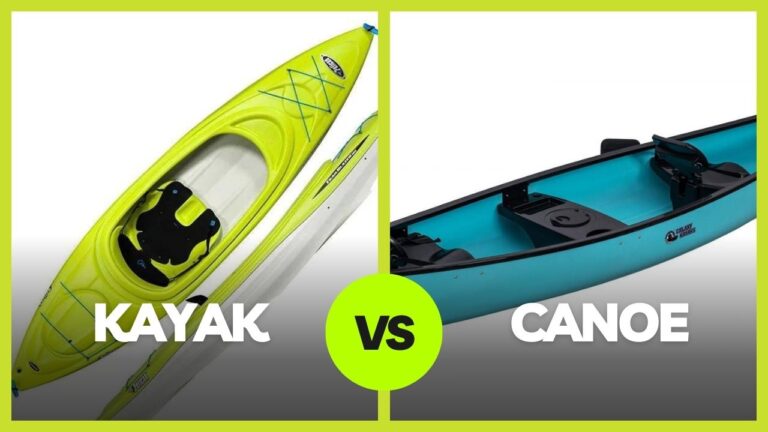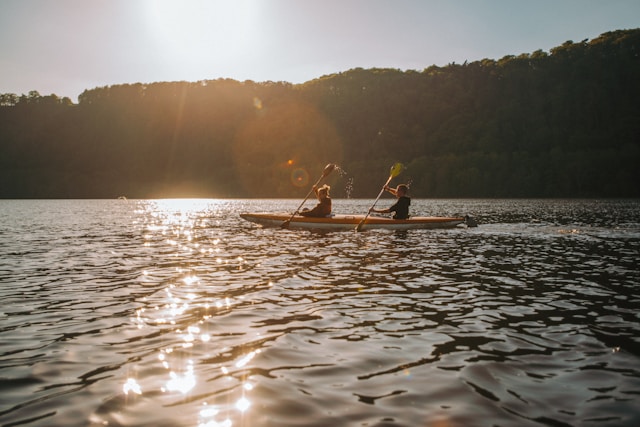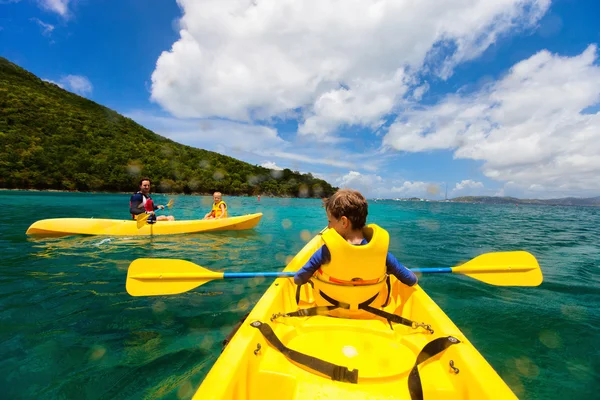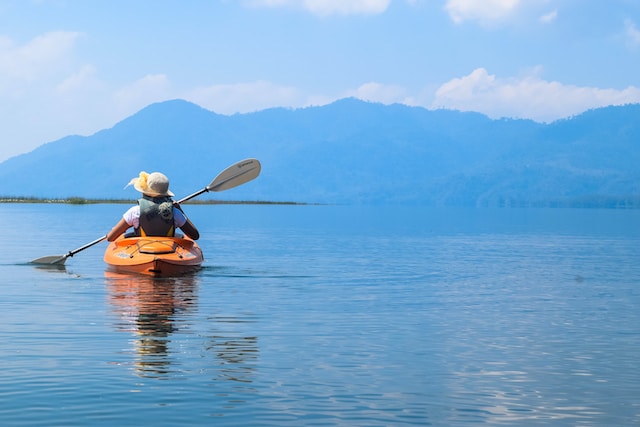Impact of Weather Conditions on Kayak Safety
Let’s talk about one thing that can make or break a kayak trip: the weather! You know the drill – skills, gear, those all matter. But sometimes, we forget just how much wind, rain, or blazing sun can change things out on the water.
Here’s why weather is important:
- Safety First: Weather can make kayaking go from chill to dangerous really quickly.
- Ruined Fun: Nobody wants to be freezing, fighting crazy wind, or getting soaked to the bone.
- Happy Paddlers: Knowing what weather to expect helps you plan a safe AND awesome trip.
So, let’s get smarter about kayaking weather! We’ll talk about how to read the forecast, what to look out for on the water, and how to adjust your plans so you have the best time possible.
Impact of Weather Conditions on Kayak Safety
Kayaking is awesome, but let’s be real – the weather can totally change your day on the water! Sometimes it’s all sunshine and smooth paddling, other times… not so much.
Understanding how wind, rain, and all that stuff impacts your kayak trip is key. It’s about safety, but also about not having a miserable time, right?
We’re gonna break down exactly how weather can mess with your kayaking plans, AND what you can do to stay safe and comfy no matter what the forecast throws at you.
Wind
Wind is one of the most significant weather factors to consider when kayaking. It can affect the water’s surface, causing waves and making your trip more challenging.
Wind direction and speed can also impact your kayak’s navigation and stability.
| Wind Direction | Impact on Kayaking |
|---|---|
| Headwind | Makes paddling more difficult and slower. |
| Tailwind | Speeds up your kayak and makes it harder to control. |
| Crosswind | Makes your kayak unstable and difficult to steer. |
Okay, got windy out there? Here’s how to handle it without ending up swimming:
- Hug the shore: It might be less scenic, but there’s usually less wind closer to land.
- Avoid the chop: Stay out of areas where the waves are hitting hard and currents are strong.
- Short and sweet strokes: Taking lots of little paddles helps you control the kayak better.
- Get low: Crouching a bit (if you can) makes the wind push less of your body around.
And remember, ALWAYS wear that lifejacket (PFD)! Especially on days when the weather might get iffy.
Related:
- HOW TO RECOVER FROM A KAYAK CAPSIZE AND RE-ENTER THE KAYAK?
- KAYAKING SAFETY: THE IMPORTANCE OF WEARING A LIFE JACKET
- ESSENTIAL KAYAKING SAFETY TIPS FOR ALL
- IS KAYAKING HARD OR EASY? FIND OUT NOW
Temperature
Listen, we tend to focus on wind when we think about kayaking weather, but getting too hot or cold is sneaky! It messes with you way more than you’d think.
Here’s the deal:
- Zap your energy: Trying to stay comfy makes you tired, meaning you’ll have less in the tank for paddling.
- Fumble fingers: Cold hands can’t grip that paddle right, making everything way harder.
- Fuzzy brain: When you’re freezing or overheating, it’s tough to think straight. Not ideal for making safe choices on the water!
But don’t worry! It’s totally possible to kayak in all sorts of weather. The key is dressing right.
Hit me up for tips on layering clothes for hot/cold days, or what to do if the weather surprises ya while you’re out there.
| Temperature | Body’s Response |
|---|---|
| High temperature | Dehydration, heat exhaustion, and sunburn. |
| Low temperature | Hypothermia, decreased dexterity, and numbness. |
Here’s how to avoid being miserable on your kayak trip! It’s all about having the right gear for the weather:
- Dress for the Forecast: This changes EVERYTHING. We’ll figure out what to wear to keep you comfy, whether it’s hot or freezing.
- Sunscreen is your BFF: Don’t get cooked out there! Even on cloudy days, that water reflects the sun like crazy.
- Water, water, water: Staying hydrated makes a HUGE difference in how you feel, especially when it’s hot.
Cold water special tips:
- Wetsuit or drysuit: A must if that water temp is low! Keeps you warm and safe.
- Layers, layers, layers: Think like an onion… you can always peel stuff off if needed.
Let me know where you’re paddling, and I’ll help you pick the perfect outfit for the weather!
Precautions to Take
Here’s your pre-paddle homework: Check the weather! Seriously, this changes EVERYTHING, especially if you’re planning a longer trip.
How to be a weather pro:
- Apps are your friend: There are tons of good ones that show wind, temperature, the whole deal.
- Go local: Find websites that give forecasts specifically for your kayaking spot.
- Never trust calm skies: Weather can change fast out on the water, so don’t get caught off guard.
Extreme weather = stay home: Thunderstorms, super high winds… not worth the risk!
Tips for Specific Weather:
- Hot days: Water bottle, hat, sunscreen, and take breaks to chill in the shade.
- Cold days: Layers that aren’t cotton, waterproof stuff, and a thermos of something hot is a lifesaver.
The bottom line: A little planning makes a HUGE difference. Being prepared helps you stay safe and actually enjoy yourself out there!
wind and its effects on kayaking
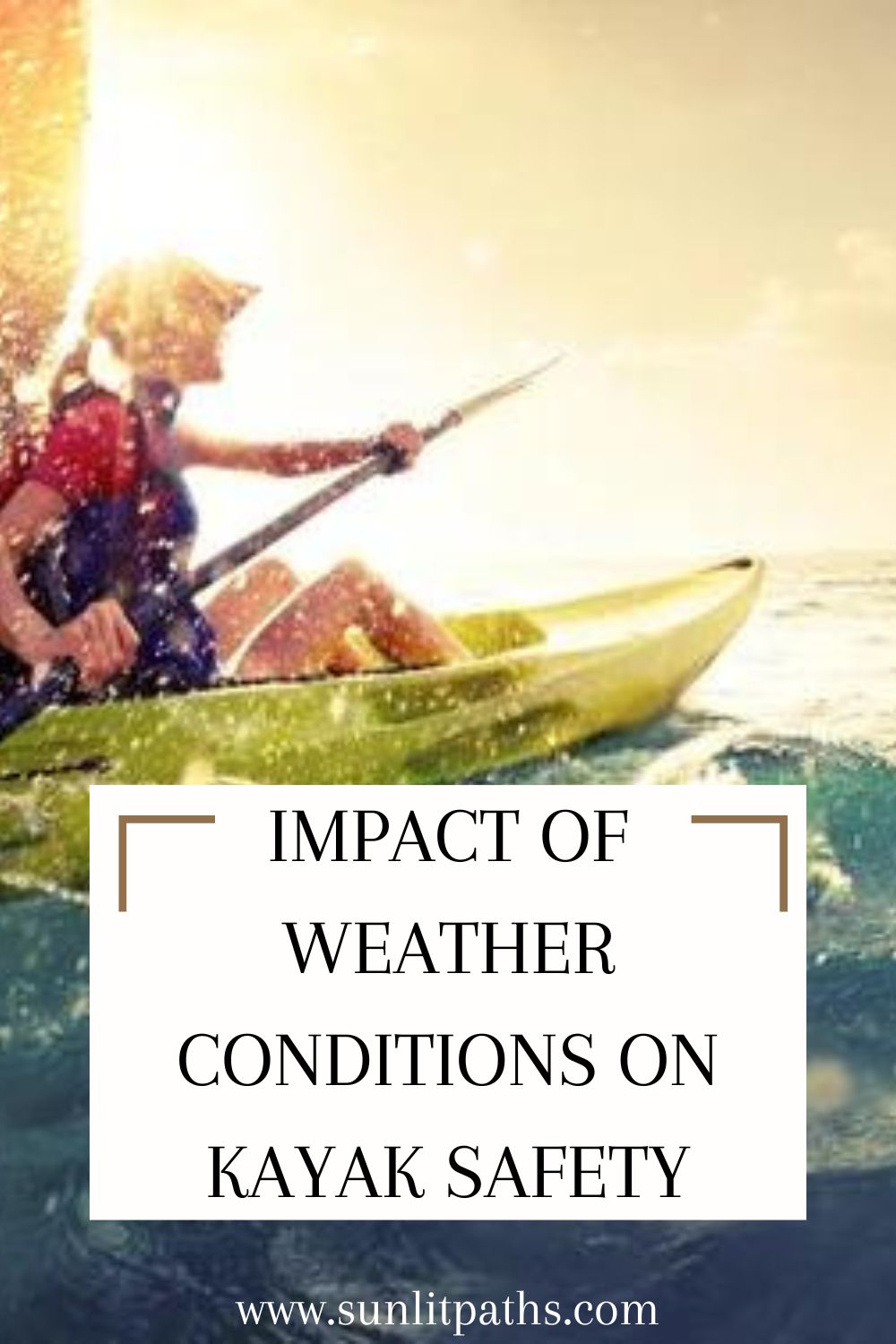
Wind is a serious deal when you’re in a kayak! It can make your trip way harder, or even turn kinda dangerous if you’re not paying attention.
Here’s what you need to know:
- Fighting for control: Wind can push your kayak off course, or make it super hard to turn when you want to.
- Slow and steady does NOT win the race: Paddling into a strong wind is a serious workout, and you won’t get very far!
- Tippy trouble: Sideways winds can make your kayak feel unstable, especially if there are waves, too.
Understanding how the wind works will keep you safe AND save you from a frustrating day fighting to go where you want.
How wind affects kayaking
Let’s break down exactly how wind messes with your kayaking trip:
- Headwinds = The Struggle: Think of it like paddling uphill, but worse. You’ll go slow and get super tired.
- Tailwinds = Speed Demon (kinda): You’ll go faster, but good luck trying to steer. It’s easy to veer off course in a hurry.
- Crosswinds = Tipsy Time: These are the worst! They push your kayak sideways, making it feel wobbly and hard to control.
- Surprise Waves: Strong gusts make for choppy water, which is no fun in a small kayak.
Bottom line: Checking the wind forecast is KEY. Here’s what to look for:
- Direction: This tells you if you’ll be fighting it, getting pushed, or dealing with those pesky side gusts.
- Speed: Strong wind = harder paddling, no matter which way it’s blowing.
How to navigate windy conditions safely
Here’s how to fight back against the wind and stay in control:
- Match the Wind: If it’s strong, you might have to paddle slower to save energy (no shame in that).
- Point that Nose: Keep the front of your kayak facing into the wind – helps you stay on track.
- Backpaddle Power: This is your secret weapon against side winds trying to spin you around.
- Sometimes, retreat is best: Fighting crazy crosswinds is rarely fun, so reschedule if possible!
- Safety First: ALWAYS wear your lifejacket (PFD), especially on windy days. Makes it way easier for someone to rescue you if needed.
Got a specific windy day problem you’re worried about? Maybe a spot where the wind always does something tricky? Let me know, I might have tips!
The impact of temperature on kayak safety
Getting too hot or too cold on the water isn’t just about being uncomfortable… it can get dangerous fast!
Here’s what can happen:
- Energy drain: Fighting to stay warm or cool zaps your energy way faster, leaving you tired for paddling.
- Bad decisions: When you’re freezing or overheated, your brain gets fuzzy. Not the best time to be figuring out navigation or dealing with tricky water.
- Serious health stuff: We’re talking frostbite, hypothermia, heat stroke… that’s way worse than just being a bit chilly.
It sounds scary, but don’t worry! Being prepared is key. Knowing the signs of trouble and dressing right for the weather can make all the difference.
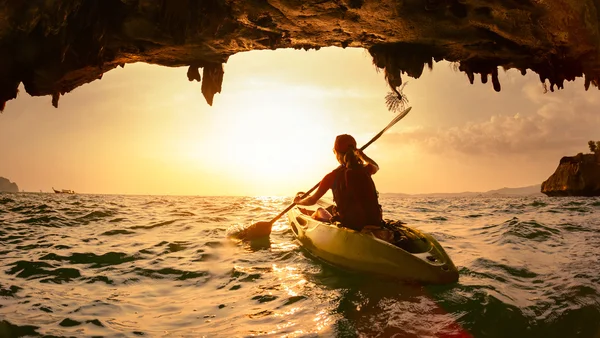
Effects of extreme heat
How Heat Messes with Your Kayak Trip:
- Dehydration Danger: You sweat more when paddling in the heat, which makes dehydration a serious risk. This isn’t just feeling thirsty, it can lead to dizziness, confusion, or even passing out.
- Energy Drain: Your body works overtime trying to keep you cool. Less energy = less fun paddling and a harder time all around.
- Sunburn City: Water reflects those rays, making sunburn happen FAST. A bad burn is no joke, especially when you’re out in the elements.
- Heat Exhaustion (or Worse!): This is where it gets serious. Overheating for too long can lead to nausea, cramps, headaches… and in extreme cases, heat stroke, which needs immediate medical attention.
Stay Safe & Comfy in Hot Weather:
- Hydrate, Hydrate, Hydrate: Drink water BEFORE you’re thirsty, and bring plenty.
- Dress Right: Lightweight, light-colored clothes, plus a hat and sunglasses.
- Sunscreen is a Must: Reapply often, even on cloudy days!
- Take Breaks: Find some shade, cool off with a splash, and rest.
- Know the Signs: Dizzy, nauseous, super tired? Get out of the sun ASAP!
Effects of extreme cold
The Dangers of Cold Weather Kayaking:
- Hypothermia: This is the big one. When your body temperature drops too low, it gets harder to function, and things can go downhill fast. Symptoms include uncontrollable shivering, confusion, and eventually loss of consciousness.
- Cold Shock: This is what happens when you first hit cold water unexpectedly. You might gasp, your heart rate spikes, and it can lead to panic and disorientation.
- Frostbite: Exposed skin, especially fingers, toes, and noses, are at risk in freezing temperatures.
- Reduced Dexterity: Cold hands make it hard to grip your paddle, manage gear, and even get back in your kayak if you capsize.
How to Stay Safe:
- Dress the Part: Layers, waterproof gear, neoprene – this isn’t just about comfort! The right clothing keeps you warm even if you get wet.
- Know Your Limits: Don’t overestimate your abilities in cold weather. Shorter paddles, calmer water, and sticking close to shore are smart choices.
- Buddy System: Always paddle with someone else in cold conditions in case someone needs help.
- Emergency Plan: Have a way to warm up, change clothes, and call for help if needed.
| Water Temperature (°F) | Expected Time Before Exhaustion | Expected Survival Time |
|---|---|---|
| 32.5 | 15 minutes | Less than 15 to 45 minutes |
| 32.5–40 | 15 – 30 minutes | 30–90 minutes |
| 40–50 | 30 – 60 minutes | 1 – 3 hours |
| 50–60 | 1 – 2 hours | 1 – 6 hours |
| 60 – 70 | 2 – 7 hours | 2 – 40 hours |
Get the Right Gear:
- Wetsuit or Drysuit: This is non-negotiable in cold water! Pick one that’s designed for the temperatures you’ll be paddling in.
- Layers are Life: Think warm base layers, fleece, and waterproof outers. You can always shed a layer if you get too hot.
- Extras Stash: Dry clothes, a hat, and gloves in a waterproof bag = lifesavers if you get wet.
Safety Stuff:
- Space Blanket: Those shiny emergency blankets are small but mighty for warming up.
- SOS Kit: Extra snacks, a way to signal for help… hope you never need it, but best to be prepared.
Listen to Your Body:
- Whether it’s blazing hot or super cold, your body tells you what’s up. Shivering, overheating, feeling dizzy… means it’s time to take a break!
Assessing Weather Conditions Before Your Kayak Trip
- Wind Watch: Check the speed AND direction. Strong gusts or winds blowing the wrong way = hard paddle, possible danger.
- Temp Trouble: Dress right, no matter if it’s crazy hot or freezing cold. Comfort = safer paddling.
- Storm Alert: Thunderstorms = stay home! Lightning + small boats don’t mix.
- Wave Warning: Big waves can be fun for experienced paddlers, but scary if you’re new. Know what to expect.
- Tide Check: Fighting against the tide is exhausting. Plan your route around when the water flow is easiest.
- Can You See? Fog or heavy rain make it tough to find your way. Sometimes it’s best to wait for clearer skies.
Gear Up for Any Weather:
- Cold Water Must-Have: Wetsuit or drysuit – no excuses! Get one made for the temps you’ll be facing.
- Layer Like an Onion: Base layer for warmth, cozy fleece on top, waterproof layer to block wind and spray. You can always peel stuff off!
- Don’t Forget the Extras: Dry clothes in a waterproof bag are emergency gold if you take an unexpected swim.
Safety Squad:
- Space Blanket = Tiny Hero: Packs small, keeps you toasty when you need it.
- SOS Kit: Snacks for energy, whistle to call for help… let’s hope it stays in your bag!
Your Body is the Boss:
- Listen up! Whether you’re sweating buckets or your teeth are chattering, those are signs to take a break. Don’t ignore them!
| Weather Element | What to Check | How to Prepare |
|---|---|---|
| Wind | Speed and direction | Adjust your route or delay your trip if winds are too strong or blowing in the wrong direction. |
| Temperature | The forecasted high and low temperatures | Dress appropriately for the weather, wear layers, and pack extra clothing in case of unexpected weather changes. |
| Thunderstorms | Possibility of thunderstorms in the area | Delay your trip if thunderstorms are predicted or plan an alternate route if possible. |
| Wave height | The height of waves | Avoid kayaking in high waves or adjust your route to avoid areas with dangerous wave conditions. |
| Tides | The strength and direction of the water flow | Plan your route carefully and avoid kayaking against a strong tide. |
| Visibility | Check for fog or other weather conditions impacting your ability to see | Delay your trip if visibility is poor or adjust your route to avoid areas with low visibility. |
By assessing weather conditions before your kayak trip, you can make informed decisions about going out on the water and take necessary precautions to ensure your safety.
Precautions to take in different weather conditions
It is important to take specific precautions when dealing with different weather conditions during your kayak trip.
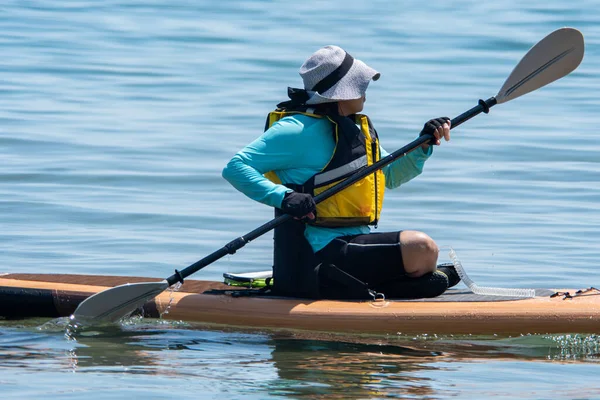
By doing so, you can ensure your safety and well-being on the water. Here are some guidelines to follow:
Strong winds are no joke! They can push you off course, create scary waves, and make paddling feel like a workout with no results. Here’s how to handle it:
- Hug the Shoreline: Calm water is usually found closer to land.
- Low and Slow: Keep your paddle close to the water for less wind resistance.
- Zig-Zag Strategy: Instead of fighting directly against the wind, paddle at a slight angle.
Thunderstorm Trouble
If you see lightning or hear thunder, GET OUT OF THE WATER! Here’s why:
- Lightning + Small Boats = Bad Idea: Find shelter on land and wait for the storm to pass.
- Ditch the Metal: Don’t touch anything conductive (paddles have metal bits!).
- Stay Low: Makes you a less obvious target for lightning.
Extreme Temps: Fight Back with the Right Gear
Both crazy heat and major cold can mess with your kayaking day. Here’s how to prepare:
- Dress for Success: Breathable layers in heat, warm layers in cold. (Tip: NO COTTON in cold weather!)
- Hydrate or Freeze: Water is essential in hot weather, warm drinks save the day in cold.
- Know Your Limits: If you start feeling sick from the temp, get out of there!
Dressing appropriately for kayak trips
Let’s talk about what to wear on your kayak adventure! It seems simple, but trust me, the right clothes make a HUGE difference for comfort and safety.
What to Wear:
- Layer Up: Think like an onion! Base layer for warmth, a fleece on top, then a waterproof outer layer. You can always peel stuff off if you get warm.
- Ditch the Cotton: It gets soggy, stays wet, and makes you cold. Not the goal! Look for quick-drying fabrics or wool instead.
- Sun Protection: Long sleeves, hats, and sunglasses are your friends, even on cloudy days. A bad sunburn is no fun.
Gear for Safety:
- Lifejacket = Non-negotiable: Always wear it right! This could literally save your life.
- Helmet Optional, Sometimes Essential: If you’re doing adventurous stuff (waterfalls, big waves), protect your noggin!
- Protect the Hands & Feet: Gloves and booties keep you comfy in cold water, and prevent blisters from paddling.
Water Temp Matters BIG TIME:
- Cold Water = Wetsuit or Drysuit: These are designed to keep you warm even if you get wet. Pick one based on how cold the water will be.
- Warm Water = Options: Swimsuit with rash guard for sun protection, or a shorty wetsuit if you want a little extra warmth.
Feet Matter Too:
- Water Shoes or Sandals: Ones with straps are great for a secure fit.
- Neoprene Booties: If the water’s cold, these are lifesavers to keep those toes from freezing!
Bottom Line: The right clothes let you focus on having fun paddling, not on being miserable!
As weather conditions can change unexpectedly during your kayak trip, it is crucial to continuously monitor the weather to ensure your safety. Here are a few tips:
- Before you set off, check the weather forecast and note any potential changes in weather patterns.
- While on the water, keep a watchful eye on the sky and clouds. Dark clouds and sudden wind gusts can signal an impending storm.
- Listen to weather updates on your marine radio or through a weather app on your smartphone. Make sure to bring a waterproof case to protect your phone.
- If you notice changes in weather conditions, consider returning to shore or finding a sheltered area until the weather subsides.
By staying aware of the weather conditions around you, you can make informed decisions and ensure your safety during your kayak trip.
Safety equipment for kayak trips
When planning for a kayak trip, safety equipment should always be a top priority.
Whether you’re an experienced paddler or a beginner, having the right gear on board can make the difference in emergency situations.
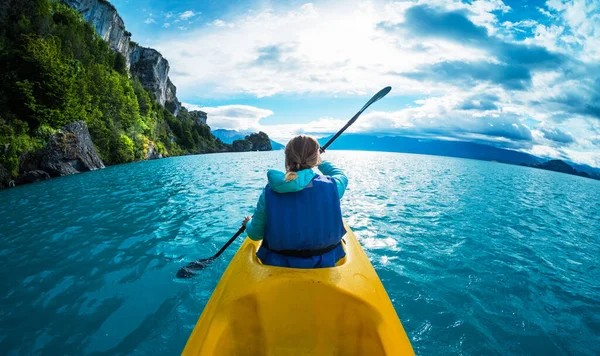
Here are some essential safety equipment items you should have on your kayak trip:
| Item | Description |
|---|---|
| Personal Flotation Device (PFD) | A PFD is a must-have item for any kayak trip. It helps keep you afloat when you fall into the water and can save your life in an emergency. Make sure it’s the right size for you and fits snugly. |
| Bilge Pump | A bilge pump helps you remove water from your kayak quickly. It’s especially useful in rough waters or when you’re caught in a storm. |
| Whistle | A whistle is a vital communication tool that can help you signal for help in an emergency. It’s also useful for communicating with other kayakers. |
| First Aid Kit | It’s always a good idea to have a first aid kit on board in case of an injury. Make sure it’s well-stocked with essentials like bandages, antiseptic wipes, and pain relievers. |
| Navigation tools | Knowing where you are and where you’re going is crucial for a safe kayak trip. Bring a map, compass, or GPS device to help you navigate. |
It’s important to note that safety equipment requirements may vary depending on your location and the type of kayak trip you’re taking.
Always do your research and make sure you have all the necessary safety gear before your trip.
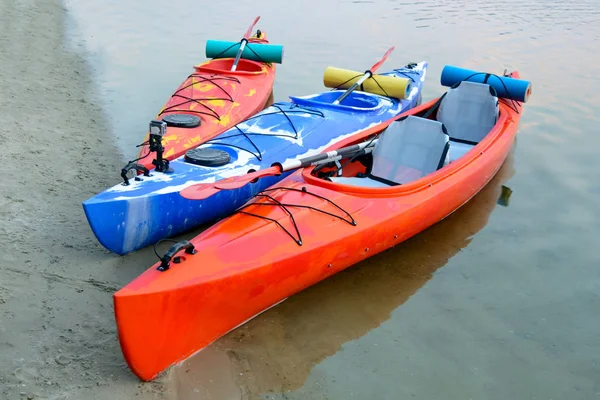
Tips for Handling Unexpected Weather Changes
Even if you plan perfectly, the weather can still surprise you. Here’s how to handle it:
- Head for Land ASAP: See dark clouds, or wind picking up? Don’t wait – get to shore before things get worse.
- Eyes on the Sky: Keep checking for changes – dark clouds, wind shifts, that “feeling” in the air before a storm.
- Is There Signal? If you can, check the forecast for the latest updates and warnings.
- Change Your Route: If you know bad weather’s hitting a certain spot, have a backup plan to paddle somewhere safer.
- Team Effort: Kayaking with buddies? Talk about what to do if the weather turns, and stick together.
- Be Prepared: First-aid kit, a way to signal for help, extra layers… best to have it and not need it!
Remember: It’s way better to be safe than sorry!
Conclusion
Okay, you’re officially way smarter about kayaking weather! Now you know how to check the forecast, dress right, and handle whatever Mother Nature throws at you.
Remember:
- Weather Check = Must-Do: A few minutes of planning can prevent a seriously bad day on the water.
- Dress for Success: The right clothes keep you comfy AND safe, no matter the temperature.
- Be Ready for Anything: Knowing what to do if the weather surprises you gives you confidence.
Bottom Line: Kayaking is awesome! Being prepared for different weather lets you focus on the fun parts – exploring, relaxing, and enjoying the beauty of being out on the water.

